Did I mention the tomatoes here are delicious? It's true that fall has almost arrived, and we are nearing the end of tomato season, but as long as they are at the roadside market, I will keep buying them to make bruschetta, sauces and soups.
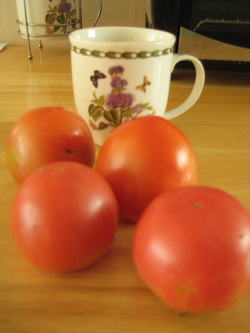 Two of my favourite things: coffee and Korean tomatoes Tomatoes on toast are a perfect breakfast. And tomatoes with toast, cheese and wine are perfect anytime. Too bad it's plastic-cheese!
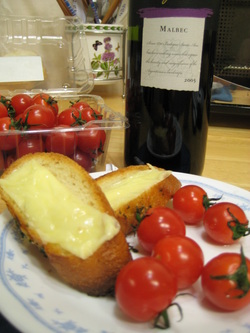 Nate loves the Malbec We spent Chuseok (Korean Thanksgiving) with an Eglish-speaking group from Seok-sa Church. It was a potluck, and I decided to bring bruschetta and spinach dip. Nate went to the market for tomatoes, but the pickings were slim, and he came back with a bag of unripened ones. We tried to ripen them in a bag with some apples, but on the day of the potluck, they were pale pink. I ran back to the market, and found only one vendor selling any. She was elderly and looked quite poor, so after staring at her tomatoes for about 3 minutes--trying to determine if they were actually ripe or just strategically displayed-- I felt compelled to purchase them. Unfortunately, many of them were split open, mealy and green. Nate did a masterful job dicing the mostly-ripe ones--we threw some sugar into the bruschetta mixture to fix the tartness--but we were left with piles of semi-ripe tomatoes... And this is what became of them....
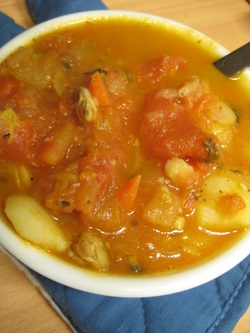 Manhatten Clam Chowder The moral of the story is, when life throws you unripe tomatoes, make clam chowder. Perfect for cool, autumn evenings in Korea!
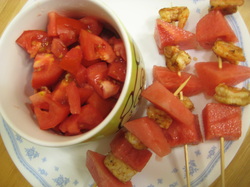 Watermelon and Shrimp Skewers plus the beginnings of bruschetta You may think this is an odd one--but it's surprisingly yummy. Pair the grilled, spicy shrimp with the cool, mellow melon and you have a light summer appetizer.
Recipe
Peel and clean 12 large shrimp.
Toss with 1 tsp. veg oil, a squeeze of lemon, salt, pepper and a pinch of cayenne-- or spicy Korean red chili powder. Grill in frypan until pink--but not chewy.
Chop a succulent, Korean watermelon (I paid the whopping equivalent of $15 for this one!).
Alternate shrimp and watermelon on a bamboo skewer.
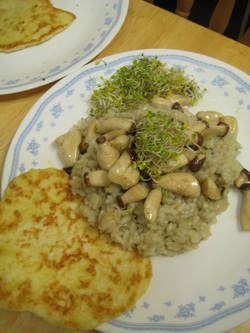 Mushroom Camembert Risotto with Naan, aka carb central! I think this recipe was originally Jamie Oliver's; however, I have butchered it so far that I should not give him credit!
Boil some water in your little, tin kettle.
Add a handful of chopped mushrooms (any variety--except white button...and of course, no poisonous varieties) to about two cups of boiling water. Soak for 10 minutes.
Fry a handful of sliced onions and a clove of diced garlic in a med-hot frypan.
Saute. Throw in a few handfuls of rice (short grain is best--calrose, sticky or arborio)--brown slightly. Add a little white wine (if you have any on hand).
Next, strain the mushrooms from your newly made broth and set aside. Gradually begin to massage about half a cup of your mushroom stock into your rice mixture.
Boil more water in your little, tin kettle. Add some boullion, or whatever you can find, to make a vegetable stock. Make as much as you can (8 cups or so) while boiling water in your little, tin kettle. Continue to massage water into your rice mixture. Ensure you heat is turned up high enough that the mixture is bubbling.
Throw in a pinch of oregano (if you have any).
If I had some thyme on my hands, I would have used it.
Add some salt and pepper and a squeeze of lemon (if you do not have lemon, a little hint of vinegar will do the trick).
Keep adding water until the rice is tender (but not mushy).
Throw in the pre-steamed mushrooms.
Mix in a couple slices of processed cheese (this is all I could find at the grocery store) but if you have real cheese, the result would be better! Camembert (at least in processed format) is a nice addition.
Taste and ensure the seasoning is perfect. Let the mixture stand over low heat.
Take another few handfuls of cleaned and dried mushrooms.
Heat a pan over medium-high heat and dry grill them (this is a Japanese technique).
Remove the mushrooms from the heat and mix in a Tablespoon or so of olive oil, a squeeze of lemon (or vinegar), some sea salt and pepper.
Serve the dressed mushrooms over the rice mixture with a sprinkle of parmesan or reggiano (if you have access to them). Garnish with something green.
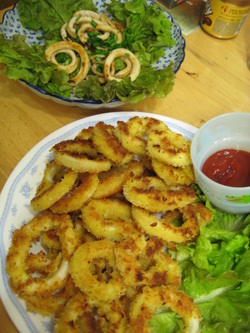 calamari with panko and calamari with green onions Maybe squid's not your thing. Maybe a fried golden coating is not a particularly healthy choice...but here you have it, pan fried calamari with spicy Korean-style ketchup.
When I saw a bag of frozen squid at the Lotte Mart (grocery store), I took some inspiration from deep fried Korean food--which seems to be most often breaded with panko (Japanese bread crumbs).
Recipe
bag of frozen squid (or use fresh if you're brave)
Run frozen squid under running water until thawed
3 eggs
Beat in a small bowl.
1 cup of flour
salt
pepper
turmeric (or spice of your choice)
Combine in a small bowl (I used turmeric to add colour).
1 bag of panko
Sprinkle a cup or so into a plastic or ziploc bag.
Assembly line style, dredge each piece of squid in the flour mixture, dip in the egg and then drop into panko and toss to coat. Set breaded squid aside.
4-5 Tbsp vegetable oil (I used soybean)
Heat your oil in a frypan over medium-high heat until it is hot (should not spit or smoke).
Pan fry a few pieces at a time. Don't crowd the pan or your oil will cool and you will have greasy little cephalopods on your hands. Cook for 1-2 minutes. Do not overcook or you will be chewing elastics.
Serve with Korean spicy ketchup (ketchup and tabasco together)
For a lighter version, toss thawed calamari with salt, pepper, paprika, olive oil, some lemon (or lemon vinegar) and chopped green onions, then pan fry for 1-2 minutes.
Yum!
 A medley of fresh vegetables and steamed clams on top of sticky rice served with a dollop of red chili sauce and shredded nori. Bibimbap is a classic Korean dish. I tried it for the first time on Korean Air and then again in a couple of restaurants. Crunchy vegetables are combined with hot rice and spicy chili sauce for a nice, balanced dish. Sometimes meat or a fried egg is added as a garnish. In my version, I used some steamed clams.
Recipe (serves 2)
1 cup sticky rice
1 1/4 cups water
(if you don't have a measuring cup, just use equal parts rice and water, then add a little more water).
Rinse the rice and soak it for fifteen minutes. Then combine the rice and water in a pot and bring to a boil over medium high heat. Reduce heat to low and simmer for about 15 minutes. Then let is stand for 10 minutes.
While the rice is cooking, steam your clams (or cook whatever protein option you are using).
Then, clean and chop your vegetables (choose what you like). I used carrots, cucumber, sprouts, green onions, white onions (marinated in vinegar) and spinach. Then, shred some nori (seaweed used to wrap sushi or kimbap).
Lastly, combine
2 Tbs red chili paste (available in everywhere in Korea)
1 Tbs soy sauce
1 tsp sesame oil
1 tsp sugar
1 tsp vinegar
Mix together in a small bowl.
To assemble your bibimbap, scoop some rice into your bowl. Add the chopped veggies and protein in a pleasing aesthetic array;) Scoop some of your sauce ontop and sprinkle with shredded nori. Voila! Bibimbap!
Rachel, my funny sister, deserves full credit for the title of this blog. Should you choose to venture here, you will find my experiments, successes and failures, cooking for one year with only a hot plate and a toaster oven--and of course, with the ingredients that are available in Korea.
Most apartments in Korea are outfitted with just a hotplate (two burners with a gas lighter). And, while It is possible to purchase a counter-top stove, in the spirit of acculturation, I'm going to get creative with what we have.
This might interest you if ...
1. you are a foreigner trying to cook in Korea.
2. you are an avid camper.
3. you get a kick out of my culinary conundrums.
I'll try to post at least one attempt per week.
Bon Appetit!
P.S. there will be very few meat dishes featured here as I am a vegetarian who eats fish and seafood. Rachel now calls me a CAYWAK (carnivore against your will and knowledge)--she coined this term to refer to a person who makes every attempt to avoid meat but is unsuccessful due to cultural ignorance and language barriers.
|




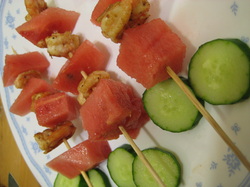

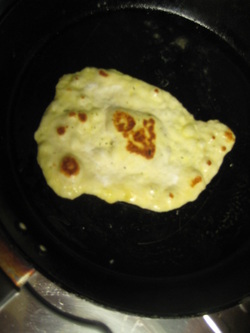


 RSS Feed
RSS Feed